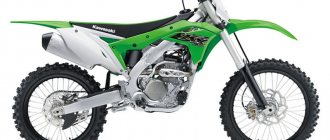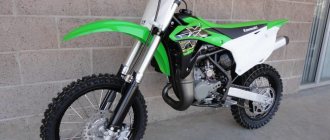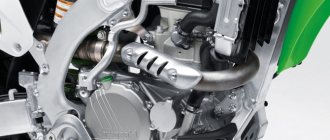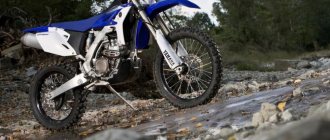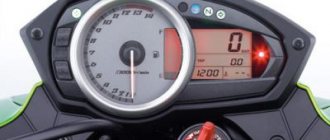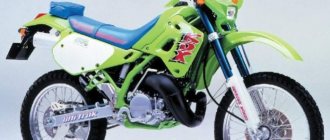| Kawasaki KX250F (KX250-N) 2004-2005 | Kawasaki KX250F (KX250-T) 2006-2008 | Kawasaki KX250F (KX250-W) 2009 | Kawasaki KX250F (KX250-X) 2010 |
| Kawasaki KX250F (KX250-Y) 2011-2012 | Kawasaki KX250F (KX250-Z) 2013-2016 | Kawasaki KX250F (KX252-A) 2017-2019 | Kawasaki KX250 (KX252-B) 2020+ |
| Kawasaki KX250 (KX252-C) 2021+ |
Kawasaki KX250F motocross model
appeared in 2004 as a replacement for the 2-stroke motocross versions of the Kawasaki KX250 and Kawasaki KX125. The first versions of the motorcycle were developed jointly with Suzuki - in the first years of production, there were two absolutely identical models on the market, Kawasaki KX250F and Suzuki RM-Z250.
In 2006, the KX250F was restyled and moved away from the concept common to the RMZ250, becoming an independent model. The updated version received a new generation of frame, redesigned engine, suspension and Renthal steering wheel.
The model is redesigned again for 2009, receiving updated exterior styling as well as redesigned engine, suspension and chassis components (to reduce weight and improve handling).
In 2010, Kawasaki released a new generation of the KX250F, although visually the model was very similar to the previous generation.
2011 was marked by another restyling of the Kawasaki KX250F, which received electronic fuel injection and a new Showa Separate Function front Fork (SFF). In 2012, a second injector was added to the fuel injection system, which slightly increased maximum power.
In 2013, the model undergoes changes again, receiving a new appearance, new settings for the injection system, engine and suspension.
For 2021, Kawasaki has introduced a new generation of the KX250F. The engine and suspension settings were changed again, the size of the front brake disc increased, and the curb weight decreased by almost 2 kg. Additional electronic accessories are also offered:
- KX FI Calibration Kit
- DFI Couplers
- Launch Control Mode
For 2021, the model is undergoing changes again, receiving a new engine, increased brake disc sizes (270 and 250 mm) and other small differences. The model also changes its name, removing the letter F - Kawasaki KX250
.
For 2021, Kawasaki introduced the new generation KX250. The updated version received a new frame, a new engine, a new electric starter system and a hydraulic clutch drive.
The main competitors of the Kawasaki KX250F in the class:
- Honda CRF250R
- Suzuki RM-Z250
- Yamaha YZ250F
Appearance
The Kawasaki KX 250F looks typical. Straight handlebars of medium height, spoked wheels, high fenders... There is no detail that would distinguish this motocross motorcycle from many others. Another thing is the technical characteristics. They're really on top here.
All variants of this car have green in their design in one way or another. For a Kawasaki bike this is not surprising.
This is a win-win design option for a sports bike. The bright green color, by the way, suits a sport bike no less well, but it’s impossible to say the same about road motorcycles. This is clear from the video and photos.
Modifications
The developers are silent about individual modifications, but in the description of the model there are both variants with symbols 250, and 252, 255. And we are not talking about the engine size.
This is probably an internal factory designation for models of different generations.
and competitors
Suzuki RM-Z250.
Honda CRF250R.
Yamaha YZ250F.
Suzuki RM-Z250 clone, Honda and Yamaha also presented their models. The first one was a Honda CRF250R . In addition to the motocross model, it also competed in the enduro class, introducing the CRF250X (also known as the CRF250RX ).
The second did not spray and presented only the Yamaha YZ250F motocross motorcycle.
All four (including Kawasaki) were launched in different years, but are still being produced.
Comfort
The car is comfortable on the track and in rural areas. Otherwise, road motorcycles and even enduro motorcycles are much more convenient. What this technique is definitely not suitable for is tourism. Neither the seat nor the tank volume help to achieve comfort while traveling.
Besides, this won't last long. Even if you plan your route correctly, you will still run out of fuel very quickly.
The car has proven itself in motocross handling. It takes turns on hills faster than many other models driven by the same professional, traverses sand better and jumps further from jumps. In many ways, this has to do with well-chosen dimensions and technical characteristics.
Features of Kawasaki KX250F
Apart from the engine, which pulls well at medium and high speeds, which is a necessity for a motocross bike, and the Launch control that appeared in 2014, the bike does not have any special differences.
An interesting feature is the ability to change engine parameters without disassembling the bike. There is a special connector on the steering column.
The card slot is located on the right side of the steering column.
- Installing a black card into it gives the command to deliver maximum power at medium speeds, which is good for hard roads.
- The white card will transfer the recoil to the top, for riding on clay or on slippery roads.
- Green - will place it in the middle between the extreme positions.
Three colors – three engine operating modes.
It is curious that the cards have a non-random name. It depends on the external design and main color of the module.
Dimensions and weight
The dimensions of this machine correspond to the tasks assigned to it. Thanks to its length and ground clearance, the bike successfully overcomes uneven surfaces.
Thanks to the height, such ground clearance is possible. Finally, thanks to the tank volume, the bike is lightweight and therefore performs well on jump stunts.
The dimensions are as follows:
- height – 1270 mm;
- width – 825 mm;
- length – 2172 mm;
- wheelbase – 1478 mm;
- seat height – 945 mm;
- ground clearance - 324 mm;
- curb weight - 104.5 kg;
- Tank capacity – 6.4 l.
The bike's curb weight makes it capable of winning motocross. At the same time, it cannot be said that these are the most successful parameters that could ideally be. Often in one review or another it is mentioned that the tank volume could be a little smaller, and then the performance would improve.
But such statements are doubtful, because this would not only create inconvenience, but would make the motorcycle unsuitable for more or less long-term competitions.
Weight
As they write in some publications: unlike competitors who are trying to create a model weighing less than 100 kg, Kawasaki does not play these games.
The developers admit that their versions are more than 100 kg, but this was done deliberately. If you use all their technologies and at the same time reduce the weight, the motorcycle will simply fly into the air, so the mass of their models is a spoiler for a sports car.
However, the weight of their product is not much different from 100 kg. The curb weight of the bike, fully fueled and ready to ride, weighs only 104 kg . During the development process it reached 106 kg .
Specifications
In terms of features, the motorcycle is a typical representative of the motocross class. A powerful engine relative to the volume and dimensions of the bike, a reliable and lightweight chassis, and a fast transmission. In short, it has everything you need to be a fast and dynamic motocross winner.
| Motor type | in-line, 1 cylinder, 4 stroke |
| Power | 43 hp |
| Torque | 28.7 Nm |
| Maximum speed | 230 km/h |
| Acceleration to 100 | 3.5 s |
| Fuel consumption per hundred | 3 l |
| Drive unit | chain |
| Transmission | five-speed |
| Frame | half-duplex aluminum |
| Rear suspension | pendulum, monoshock absorber, stroke 310 mm |
| Front suspension | inverted fork, 310 mm travel |
| Rear brakes | 1 disc, 240 mm, 1-piston caliper |
| Front brakes | 1 disc, 270 mm, 2-piston caliper |
All this makes this bike stop on time, be strong and soft on jump landings, and be relatively loud. The latter, however, applies to most representatives of the cross-country class. This is why they are not yet suitable for crowded places. The sound of the engine is similar to the sound of a chainsaw.
Reviews
Reviews about Kawasaki KX250F:
Expand Collapse
First impressions are positive:
— the weight is greater than that of the YZ and these few kilos are felt: more inertia at the entrance to the turn, more stable movement on the straight line, jumps a little harder;
— the suspension is a little more assembled, it works perfectly, or rather, it works unnoticed by me, which is a buzz;
— It’s easier to take turns due to the linearity of power delivery: tilt it to the desired angle, open the gas almost at the beginning of the turn, and off you go. but, on the other hand, you have to choose smoother trajectories, there is not that explosive power to break the trajectory as easily as on 2T. In general, you have to drive more smoothly, so “ragged” both in rhythm and trajectory;
— power: enough for now, although I still don’t understand where one gear has already ended and it’s time to shift higher, but this is a matter of habit. and the ringing of a two-stroke engine is still missing, by which you can also navigate;
— at the last training session there was a hard seat from Aserbis, it really beat my ass to the point of bruises, now I have a soft stock seat, the ride has become hellishly more comfortable, you can even ride after turns while sitting;
— The steering wheel will need to be changed, this one is narrower and bent back more. It doesn’t seem like a big dial, but it’s more convenient on the Yamaha.
What do the owners say?
Judging by the reviews, this bike is great for motocross. It is advised to take this model, since it is still in production and meets all the requirements of current competitions and environmental standards.
Spare parts for this equipment are easy to obtain, and therefore maintenance will not be expensive. For the cross-country version, this is important, because no matter how strong the equipment, the risk of breakdowns is high due to extreme operating conditions.
Of course, all owners advise buying a new bike. It is possible to get a good used one, but there is a risk that something somewhere will break faster. According to the owners' description, the motorcycle handles well in rural areas, but is less comfortable on the road than road variants and even enduros.
It is possible to buy new equipment for about 300 thousand Russian rubles, but according to reviews from those who bought a used one, in this case it is possible to purchase a bike several times cheaper. About 150 thousand Russian rubles - that’s how much such a bike costs on the secondary market. But this is the minimum.
In conclusion, it is worth noting that the Kawasaki KX 250F is a machine that has proven itself. The bike looks interesting and bright. It does not and cannot have any special differences from other motocross bikes. These machines have been made approximately the same for many decades.
Brief history of the model
- 2004 - start of production and sales. First generation
.
Model
: Kawasaki KX250F (North America, Europe, Australia, Japan).
Factory designation:
KX250-N1.
- 2005 - no significant changes.
Model
: Kawasaki KX250F (North America, Europe, Australia, Japan).
Factory designation:
KX250-N2.
- 2006 - restyling of the model. Second generation
.
Model
: Kawasaki KX250F (North America, Europe, Australia, Japan).
Factory designation:
KX250T6F.
- 2007 - no significant changes.
Model
: Kawasaki KX250F (North America, Europe, Australia, Japan).
Factory designation:
KX250T7F.
- 2008 - no significant changes.
Model
: Kawasaki KX250F (North America, Europe, Australia, Japan).
Factory designation:
KX250T8F.
- 2009 - restyling of the model. Third generation
.
Model
: Kawasaki KX250F (North America, Europe, Australia, Japan).
Factory designation:
KX250W9F.
- 2010 - restyling of the model. Fourth generation
.
Model
: Kawasaki KX250F (North America, Europe, Australia, Japan).
Factory designation:
KX250XAFA, KX250XAFB.
- 2011 - restyling of the model. Fifth generation
.
Model
: Kawasaki KX250F (North America, Europe, Australia, Japan).
Factory designation:
KX250YBF.
- 2012 - the model receives a dual fuel injection system, which includes a lower and upper injector. The lower injector is responsible for a constant, uniform response from the throttle, and the upper injector is responsible for increasing power. As the speed increases, the computer unit switches from the lower to the upper injector.
Model
: Kawasaki KX250F (North America, Europe, Australia, Japan).
Factory designation:
KX250YCF.
- 2013 - restyling of the model. Sixth generation
.
Model
: Kawasaki KX250F (North America, Europe, Australia, Japan).
Factory designation:
KX250ZDF.
- 2014 - no significant changes.
Model
: Kawasaki KX250F (North America, Europe, Australia, Japan).
Factory designation:
KX250ZEF.
- 2015 - no significant changes.
Model
: Kawasaki KX250F (North America, Europe, Australia, Japan).
Factory designation:
KX250ZFF.
- 2016 - no significant changes.
Model
: Kawasaki KX250F (North America, Europe, Australia, Japan).
Factory designation:
KX250ZGF.
- 2017 - restyling of the model. Seventh generation
.
Model
: Kawasaki KX250F (North America, Europe, Australia, Japan).
Factory designation:
KX252AHF.
- 2018 - no significant changes.
Model
: Kawasaki KX250F (North America, Europe, Australia, Japan).
Factory designation:
KX252AJF.
- 2019 - no significant changes.
Model
: Kawasaki KX250F (North America, Europe, Australia, Japan).
Factory designation:
KX252AKF.
- 2020 - restyling of the model. Eighth generation
.
Model
: Kawasaki KX250 (North America, Europe, Australia, Japan).
Factory designation:
KX252BLF.
- 2021 - restyling of the model. Ninth generation
.
Model
: Kawasaki KX250 (North America, Europe, Australia, Japan).
Factory designation:
KX252CMFNN.
- 2022 - no significant changes.
Model
: Kawasaki KX250 (North America, Europe, Australia, Japan).
Factory designation:
KX252CNFNN.
Flaws
- Loud muffler — even forward flow cannot compare with the howl of the engine in a normal situation.
The muffler is raised right under the saddle and covered with a protective pad.
- Lack of power at low revs - do not forget that the motorcycle is not for regular riding, but for circuit racing, where people usually ride at other rev ranges.
and dignity
The main competitive advantage of the model is, of course, the power plant. It was Kawasaki that was the first to cross the 40 hp bar. With. and raised the requirements for motocross motorcycles to a new level.
At the same time it is noted:
- Comfortable fit . Although the pilot does not often sit during the race, the saddle is quite large - not typical for ordinary cross-country models.
- Handling is a necessary quality for a cross-country model.
- Stability on a given track . For cross-country, this is rather an exception to the rule, but a positive exception.
- Price . The brand does not always have a price-quality ratio in favor of the latter, but by assembling this model, the developers managed to create a balanced ratio of one to the other.
Naturally, power is also a plus, but here they write about excellent power and output at high and medium speeds.
